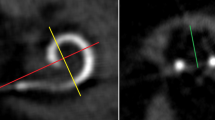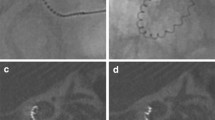Abstract
Purpose
In cochlear implantation, a scala vestibuli (SV) insertion of an electrode array is a rare occurrence and is reported to be linked to poor hearing outcomes. Using the same electrode array, the auditory performance of patients with a complete SV location was compared with that of patients having a complete scala tympani (ST) location 1 year after implantation.
Methods
Thirty-three patients were included in this retrospective case–control study (SV, n = 12; ST, n = 21). The matching criteria were electrode array type, age at implantation, and duration of severe or profound deafness. The array location was analyzed using 3D reconstruction of postoperative CT scans. Postoperative audiological evaluation of the implanted ear was performed using pure-tone audiometry, speech recognition of monosyllabic words in quiet, and words and sentences in noise.
Results
On the preoperative CT scan, six patients in the SV group presented with both round window (RW) and ST ossification, three with RW ossification alone, and three with no RW ossification. Auditory performance did not differ between SV and ST groups 1 year after cochlear implantation. Speech recognition of words was 49 ± 7.6% and 56 ± 5.0% in quiet and 75 ± 9.5% and 66 ± 6.0% in noise in SV and ST groups, respectively.
Conclusion
ST insertion is the gold standard that allows the three cochlear scalae to preserve scalar cochlear integrity. However, 1 year after implantation, a planned or unexpected SV insertion is not detrimental to hearing outcomes, providing similar auditory performance in quiet and noise to ST insertion.



Similar content being viewed by others
Data Availability
The data that support the findings of this study are not publicly available due to the internal institutional policy but are available from the corresponding author upon reasonable request.
References
Wanna GB, Noble JH, Carlson ML et al (2014) Impact of electrode design and surgical approach on scalar location and cochlear implant outcomes. Laryngoscope 124(Suppl 6):S1-7. https://doi.org/10.1002/lary.24728
O’Connell BP, Cakir A, Hunter JB et al (2016) Electrode location and angular insertion depth are predictors of audiologic outcomes in cochlear implantation. Otol Neurotol 37:1016–1023. https://doi.org/10.1097/MAO.0000000000001125
Connor SE, Holland NJ, Agger A et al (2012) Round window electrode insertion potentiates retention in the scala tympani. Acta Otolaryngol 132:932–937. https://doi.org/10.3109/00016489.2012.680493
Fischer N, Pinggera L, Weichbold V et al (2015) Radiologic and functional evaluation of electrode dislocation from the scala tympani to the scala vestibuli in patients with cochlear implants. Am J Neuroradiol 36:372–377. https://doi.org/10.3174/ajnr.A4189
Eisenhut F, Taha L, Kleibe I et al (2020) Fusion of preoperative MRI and postoperative FD-CT for direct evaluation of Cochlear implants: an analysis at 1.5 T and 3 T. Clin Neuroradiol 30:729–737. https://doi.org/10.1007/s00062-019-00853-6
Daoudi H, Lahlou G, Torres R et al (2021) Robot-assisted Cochlear implant electrode array insertion in adults: a comparative study with manual insertion. Otol Neurotol 42:e438–e444. https://doi.org/10.1097/MAO.0000000000003002
Dong Y, Briaire JJ, Siebrecht M, Stronks HC, Frijns JHM (2021) Detection of translocation of Cochlear implant electrode arrays by intracochlear impedance measurements. Ear Hear 42:1397–1404. https://doi.org/10.1097/AUD.0000000000001033
Torres R, Daoudi H, Lahlou G et al (2021) Restoration of high frequency auditory perception after robot-assisted or manual cochlear implantation in profoundly deaf adults improves speech recognition. Front Surg 10(8):729736. https://doi.org/10.3389/fsurg.2021.729736
Gulya AJ, Steenerson RL (1996) The scala vestibuli for cochlear implantation. An anatomic study. Arch Otolaryngol Head Neck Surg 122:130–132. https://doi.org/10.1001/archotol.1996.01890140020005
Shaul C, Dragovic AS, Stringer AK et al (2018) Scalar localisation of peri-modiolar electrodes and speech perception outcomes. J Laryngol Otol 132:1000–1006. https://doi.org/10.1017/S0022215118001871
Wanna GB, Noble JH, Gifford RH et al (2015) Impact of intrascalar electrode location, electrode type, and angular insertion depth on residual hearing in cochlear implant patients: preliminary results. Otol Neurotol 36:1343–1348. https://doi.org/10.1097/MAO.0000000000000829
Riggs WJ, Dwyer RT, Holder JT et al (2019) Intracochlear electrocochleography: influence of scalar position of the cochlear implant electrode on postinsertion results. Otol Neurotol 40:e503–e510. https://doi.org/10.1097/MAO.0000000000002202
Gantz BJ, McCabe BF, Tyler RS (1988) Use of multichannel cochlear implants in obstructed and obliterated cochleas. Otolaryngol Head Neck Surg 98:72–81. https://doi.org/10.1177/019459988809800113
Zhang N, Dong R, Zheng J et al (2022) Cochlear implantation for post-meningitis deafness with cochlear ossification: diagnosis and surgical strategy. Acta Otolaryngol (Stockh) 142:369–374. https://doi.org/10.1080/00016489.2022.2077433
Hassepass F, Schild C, Aschendorff A et al (2013) Clinical outcome after cochlear implantation in patients with unilateral hearing loss due to labyrinthitis ossificans. Otol Neurotol 34:1278–1283. https://doi.org/10.1097/MAO.0b013e3182937ad4
Vashishth A, Fulcheri A, Prasad SC et al (2018) Cochlear implantation in cochlear ossification: retrospective review of etiologies, surgical considerations, and auditory outcomes. Otol Neurotol 39:17–28. https://doi.org/10.1097/MAO.0000000000001613
Wang L, Zhang D (2014) Surgical methods and postoperative results of cochlear implantation in 79 cases of ossified cochlea. Acta Otolaryngol (Stockh) 134:1219–1224. https://doi.org/10.3109/00016489.2014.947656
Stuermer K, Winter T, Nachtsheim L et al (2021) Round window accessibility during cochlear implantation. Eur Arch Otorhinolaryngol 278:363–370. https://doi.org/10.1007/s00405-020-06095-4
Jwair S, van Eijden JJM, Blijleven EE et al (2022) Radiological and surgical aspects of round window visibility during cochlear implantation: a retrospective analysis. Eur Arch Otorhinolaryngol 279:67–74. https://doi.org/10.1007/s00405-021-06611-0
Adunka O, Kiefer J, Unkelbach MH et al (2005) Evaluating cochlear implant trauma to the scala vestibuli. Clin Otolaryngol 30:121–127. https://doi.org/10.1111/j.1365-2273.2004.00935.x
Lin Y-S (2009) Clinical outcomes of scala vestibuli cochlear implantation in children with partial labyrinthine ossification. Acta Otolaryngol (Stockh) 129:273–280. https://doi.org/10.1080/00016480802032819
Trudel M, Côté M, Philippon D et al (2018) Comparative impacts of scala vestibuli versus scala tympani cochlear implantation on auditory performances and programming parameters in partially ossified cochleae. Otol Neurotol 39:700–706. https://doi.org/10.1097/MAO.0000000000001816
Aschendorff A, Kromeier J, Klenzner T, Laszig R (2007) Quality control after insertion of the nucleus contour and contour advance electrode in adults. Ear Hear 28:75S-79S. https://doi.org/10.1097/AUD.0b013e318031542e
Kiefer J, Weber A, Pfennigdorff T, von Ilberg C (2000) Scala vestibuli insertion in cochlear implantation: a valuable alternative for cases with obstructed scala tympani. J Otorhinolaryngol Relat Spec 62:251–256. https://doi.org/10.1159/000027755
Smullen JL, Balkany TJ (2005) Implantation of the ossified Cochlea. Oper Tech Otolaryngol Head Neck Surg 16:117–120. https://doi.org/10.1016/j.otot.2005.03.005
Torres R, Tinevez J-Y, Daoudi H et al (2022) Best fit 3D basilar membrane reconstruction to routinely assess the scalar position of the electrode array after Cochlear implantation. J Clin Med 11:2075. https://doi.org/10.3390/jcm11082075
Monsell EM, Balkany TA, Gates GA et al (1995) Committee on hearing and equilibrium guidelines for the evaluation of hearing preservation in acoustic neuroma (vestibular schwannoma). Mosby-Year Book Inc, St Louis
Steenerson RL, Gary LB, Wynens MS (1990) Scala vestibuli cochlear implantation for labyrinthine ossification. Am J Otol 11:360–363
Holden LK, Finley CC, Firszt JB et al (2013) Factors affecting open-set word recognition in adults with cochlear implants. Ear Hear 34:342–360. https://doi.org/10.1097/AUD.0b013e3182741aa7
Lin K, Marrinan MS, Waltzman SB, Roland JT (2006) Multichannel cochlear implantation in the scala vestibuli. Otol Neurotol 27:634–638. https://doi.org/10.1097/01.mao.0000224095.63354.1a
Adunka OF, Radeloff A, Gstoettner WK et al (2007) Scala tympani cochleostomy II: topography and histology. Laryngoscope 117:2195–2200. https://doi.org/10.1097/MLG.0b013e3181453a53
Berrettini S, Forli F, Passetti S (2008) Preservation of residual hearing following cochlear implantation: comparison between three surgical techniques. J Laryngol Otol 122:246–252. https://doi.org/10.1017/S0022215107000254
Briggs RJS, Tykocinski M, Stidham K, Roberson JB (2005) Cochleostomy site: implications for electrode placement and hearing preservation. Acta Otolaryngol (Stockh) 125:870–876. https://doi.org/10.1080/00016480510031489
Bauer PW, Roland PS (2004) Clinical results with the Med-El compressed and split arrays in the United States. Laryngoscope 114:428–433. https://doi.org/10.1097/00005537-200403000-00009
Hoffmann JAC, Warnecke A, Timm ME et al (2022) Cochlear implantation in obliterated Cochlea: a retrospective analysis and comparison between the IES stiff custom-made device and the split-array and regular electrodes. J Clin Med 11:6090. https://doi.org/10.3390/jcm11206090
Öztürk K, Göde S, Çelik S et al (2016) Revisiting the anatomy of the facial recess: the boundaries of the round window exposure. Balk Med J 33:552–555. https://doi.org/10.5152/balkanmedj.2016.150864
Kelsall D, Lupo J, Biever A (2021) Longitudinal outcomes of cochlear implantation and bimodal hearing in a large group of adults: a multicenter clinical study. Am J Otolaryngol 42:102773. https://doi.org/10.1016/j.amjoto.2020.102773
De Seta D, Nguyen Y, Bonnard D (2016) The role of electrode placement in bilateral simultaneously cochlear-implanted adult patients. Otolaryngol Head Neck Surg 155:485–493. https://doi.org/10.1177/0194599816645774
Millar DA, Hillman TA, Shelton C (2005) Implantation of the ossified cochlea: management with the split electrode array. Laryngoscope 115:2155–2160. https://doi.org/10.1097/01.MLG.0000181494.21654.5E
Funding
The study was supported by research funding from Fondation Pour l’Audition (FPA CRA02), Fondation pour l’Audition (Starting Grant IDA-2020), and ANR Robocop ANR-19-CE19-0026-02.
Author information
Authors and Affiliations
Corresponding author
Ethics declarations
Conflict of interest
There are no conflicts of interest, financial, or otherwise.
Additional information
Publisher's Note
Springer Nature remains neutral with regard to jurisdictional claims in published maps and institutional affiliations.
Supplementary Information
Below is the link to the electronic supplementary material.
In this video, we observe the 3D reconstruction of the post-operative CT scan showing the temporal bone surface and the transmastoid approach performed during the surgery. At 00:10, we observe the promontory, the ossicular chain, and the electrode array through the posterior tympanotomy. Moving on to 00:21, we observe the promontory from the external auditory canal. At 00:35, we observe the cochleostomy and the round window niche. Finally, at 00:45, we observe the promontory from different angles in an attempt to determine the position of the round window niche, but the round window niche was unidentifiable (M4V 17987 KB)
Rights and permissions
Springer Nature or its licensor (e.g. a society or other partner) holds exclusive rights to this article under a publishing agreement with the author(s) or other rightsholder(s); author self-archiving of the accepted manuscript version of this article is solely governed by the terms of such publishing agreement and applicable law.
About this article
Cite this article
Gu, W., Daoudi, H., Lahlou, G. et al. Auditory outcomes after scala vestibuli array insertion are similar to those after scala tympani insertion 1 year after cochlear implantation. Eur Arch Otorhinolaryngol 281, 155–162 (2024). https://doi.org/10.1007/s00405-023-08107-5
Received:
Accepted:
Published:
Issue Date:
DOI: https://doi.org/10.1007/s00405-023-08107-5




